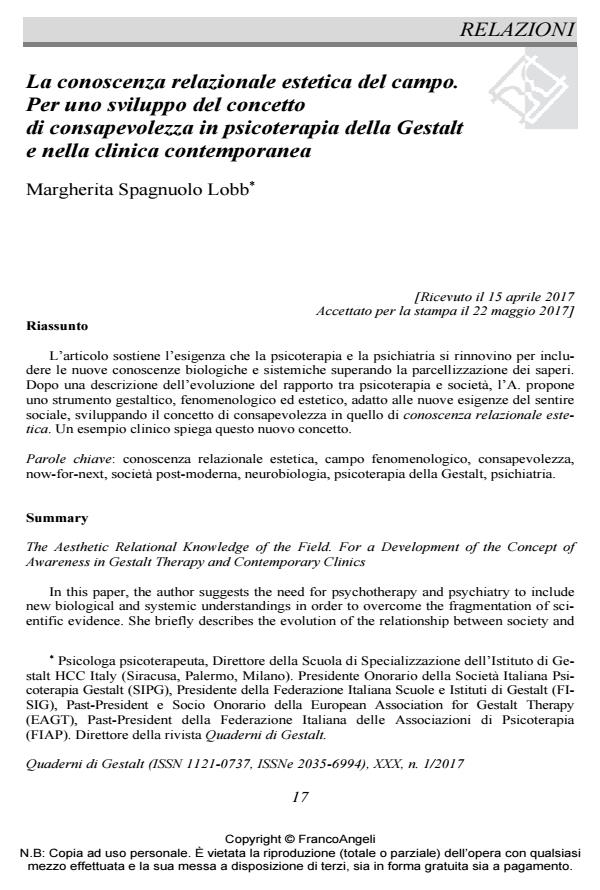The Aesthetic Relational Knowledge of the Field. For a Development of the Concept of Awareness in Gestalt Therapy and Contemporary Clinics
Journal title QUADERNI DI GESTALT
Author/s Margherita Spagnuolo Lobb
Publishing Year 2017 Issue 2017/1
Language Italian Pages 17 P. 17-33 File size 218 KB
DOI 10.3280/GEST2017-001003
DOI is like a bar code for intellectual property: to have more infomation
click here
Below, you can see the article first page
If you want to buy this article in PDF format, you can do it, following the instructions to buy download credits

FrancoAngeli is member of Publishers International Linking Association, Inc (PILA), a not-for-profit association which run the CrossRef service enabling links to and from online scholarly content.
In this paper, the author suggests the need for psychotherapy and psychiatry to include new biological and systemic understandings in order to overcome the fragmentation of scientific evidence. She briefly describes the evolution of the relationship between society and psychotherapy and then she introduces a new development in Gestalt therapy. This development is the extension of awareness into the more phenomenological and aesthetic concept of aesthetic relational knowledge. This new concept includes both the therapeutic competences of empathy and to be able to resonate with the client in the co-created field. A clinical example then demonstrates these concepts.
Keywords: Aesthetic relational knowledge, phenomenological field, awareness, now-for-next, post-modern society, neurobiological studies, Gestalt psychotherapy, psychiatry.
- Cartacci F. (2025), Per una cura sensibile. Psicomotricità e Gestalt. Milano: Franco Angeli. ISBN: 9788835160649, pp.240, euro 32,00 Fabiola Maggio, in QUADERNI DI GESTALT 1/2025 pp.105
DOI: 10.3280/qg2025-1oa18242 - L'es in psicoterapia della Gestalt Mercurio Albino Macaluso, in QUADERNI DI GESTALT 1/2022 pp.47
DOI: 10.3280/GEST2022-001004 - Essere psicoterapeuta della Gestalt al tempo del Coronavirus: Percepire lo sfondo esperienziale e "danzare" con reciprocità Margherita Spagnuolo Lobb, in QUADERNI DI GESTALT 1/2021 pp.33
DOI: 10.3280/GEST2021-001005 - Intenzionalità e spontaneità nell'azione terapeutica gestaltica Mercurio Albino Macaluso, in QUADERNI DI GESTALT 1/2018 pp.33
DOI: 10.3280/GEST2018-001004 - Longevità, vitalità e sport in psicoterapia della Gestalt Salvatore Armando Cammarata, in QUADERNI DI GESTALT 2/2024 pp.65
DOI: 10.3280/GEST2023-002005 - Dalla perdita delle funzioniio ai "passi di danza" tra psicoterapeuta e paziente. Fenomenologia ed estetica del contatto nel campo psicoterapeutico Margherita Spagnuolo Lobb, in QUADERNI DI GESTALT 1/2020 pp.21
DOI: 10.3280/GEST2020-001003 - La scheda clinica gestaltica: presentazione di uno strumento di lavoro Margherita Spagnuolo Lobb, Elisabetta Conte, Maria Mione, in QUADERNI DI GESTALT 2/2018 pp.67
DOI: 10.3280/GEST2017-002005 - La fenomenologia del contatto in una seduta Margherita Spagnuolo Lobb, Teresa Borino, in QUADERNI DI GESTALT 1/2017 pp.53
DOI: 10.3280/GEST2017-001005 - Recensioni Silvia Tosi, in QUADERNI DI GESTALT 1/2022 pp.95
DOI: 10.3280/GEST2022-001007 - La discrétion. La rencontre avec Isadore From Margherita Spagnuolo Lobb, Joseph Caccamo, in Cahiers de Gestalt-thérapie /2022 pp.81
DOI: 10.3917/cges.047.0081 - Il sogno nella relazione e la relazione nel sogno Martin Jára, in QUADERNI DI GESTALT 2/2018 pp.53
DOI: 10.3280/GEST2018-002008 - Una lettura gestaltica dei disturbi psicosomatici: "la pelle che brucia" Michele Cannavò, Dario Davì, Brenda Cervellione, in QUADERNI DI GESTALT 2/2024 pp.33
DOI: 10.3280/qg2024-2oa18163 - Coltivare la presenza in un gruppo. Consapevolezza gestaltica e Mindfulness. Seminario di focalizzazione esperienziale. Mondello (Palermo), 7-8 Febbraio 2025 Carola Augello, Luciana Taffaro, in QUADERNI DI GESTALT 1/2025 pp.109
DOI: 10.3280/qg2025-1oa19950 - L'uso delle immagini e della fotografia nella psicoterapia della Gestalt. Neuroestetica, neuroni specchio e risonanza corporea Michele Cannavò, Jelena Zeleskov Doric, Alessandro Cereda, Azzurra G.M. Alù, in QUADERNI DI GESTALT 2/2021 pp.29
DOI: 10.3280/GEST2021-002003 - Buongiorno, Professor Borgna! Lettera a un maestro dell'oscuro e del luminoso Maria Mione, in QUADERNI DI GESTALT 1/2025 pp.115
DOI: 10.3280/qg2025-1oa20564 - La supervisione in psicoterapia della Gestalt: la prospettiva situazionale come antidoto contro la vergogna Margherita Spagnuolo Lobb, in QUADERNI DI GESTALT 1/2024 pp.27
DOI: 10.3280/qg2024-1oa17952 - La spiritualità incarnata in psicoterapia della Gestalt Silvia Alaimo, in QUADERNI DI GESTALT 1/2018 pp.59
DOI: 10.3280/GEST2018-001005 - Il senso della morte nei bambini. Psicoterapia della Gestalt ed ematoncologia pediatrica. Dialogo tra Momcilo Jankovice Margherita Spagnuolo Lobb Mariangela Patti, in QUADERNI DI GESTALT 1/2022 pp.11
DOI: 10.3280/GEST2022-001002 - Il dolore che non posso sentire. Aspetti clinici e neurobiologici del disturbo di panico Rosanna Biasi, Michele Cannavò, in QUADERNI DI GESTALT 1/2025 pp.51
DOI: 10.3280/qg2025-1oa19318 - Gestalt Family Therapy in azione Margherita Spagnuolo Lobb, Elisabetta Conte, in QUADERNI DI GESTALT 1/2018 pp.71
DOI: 10.3280/GEST2018-001006 - Il concetto di "campo" in psicoterapia della Gestalt. Sviluppi e implicazioni Mercurio Albino Macaluso, in QUADERNI DI GESTALT 1/2020 pp.57
DOI: 10.3280/GEST2020-001005 - Sentire-con: il supervisore e l'esperienza del gruppo Ezio Farinetti, in QUADERNI DI GESTALT 2/2018 pp.67
DOI: 10.3280/GEST2018-002009
Margherita Spagnuolo Lobb, La conoscenza relazionale estetica del campo. Per uno sviluppo del concetto di consapevolezza in psicoterapia della Gestalt e nella clinica contemporanea in "QUADERNI DI GESTALT" 1/2017, pp 17-33, DOI: 10.3280/GEST2017-001003